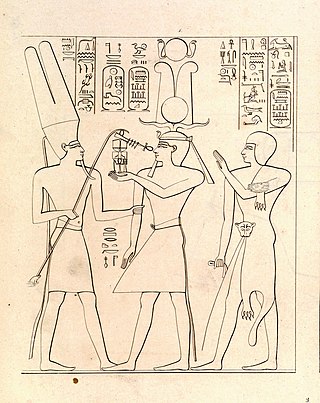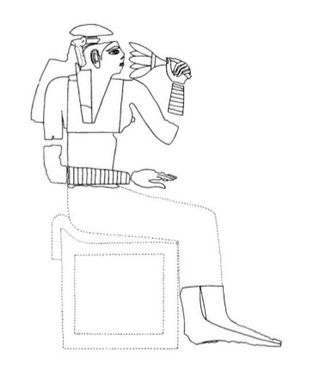
Tanis or San al-Hagar is the Greek name for ancient Egyptian ḏꜥn.t, an important archaeological site in the northeastern Nile Delta of Egypt, and the location of a city of the same name. It is located on the Tanitic branch of the Nile, which has long since silted up.

The tomb of Tutankhamun, a pharaoh of the Eighteenth Dynasty of ancient Egypt, is located in the Valley of the Kings. The tomb, also known by its tomb number KV62, consists of four chambers and an entrance staircase and corridor. It is smaller and less extensively decorated than other Egyptian royal tombs of its time, and it probably originated as a tomb for a non-royal individual that was adapted for Tutankhamun's use after his premature death. Like other pharaohs, Tutankhamun was buried with a wide variety of funerary objects and personal possessions, such as coffins, furniture, clothing and jewelry, though in the unusually limited space these goods had to be densely packed. Robbers entered the tomb twice in the years immediately following the burial, but Tutankhamun's mummy and most of the burial goods remained intact. The tomb's low position, dug into the floor of the valley, allowed its entrance to be hidden by debris deposited by flooding and tomb construction. Thus, unlike other tombs in the valley, it was not stripped of its valuables during the Third Intermediate Period.

Hedjkheperre Setepenre Shoshenq I —also known as Shashank or Sheshonk or Sheshonq I—was a pharaoh of ancient Egypt and the founder of the Twenty-second Dynasty of Egypt.

Titkheperure or Tyetkheperre Psusennes II [Greek Ψουσέννης] or Hor-Pasebakhaenniut II [Egyptian ḥr-p3-sb3-ḫˁỉ-⟨n⟩-nỉwt], was the last king of the Twenty-first Dynasty of Egypt.

Hedjkheperre Setepenre Takelot II Si-Ese was a pharaoh of the Twenty-third Dynasty of Ancient Egypt in Middle and Upper Egypt. He has been identified as the High Priest of Amun Takelot F, son of the High Priest of Amun Nimlot C at Thebes, and thus, the son of Nimlot C and grandson of king Osorkon II, according to the latest academic research. Based on two lunar dates belonging to Takelot II, this Upper Egyptian pharaoh is today believed to have ascended to the throne of a divided Egypt in either 845 BC or 834 BC. Most Egyptologists today, including Aidan Dodson, Gerard Broekman, Jürgen von Beckerath, M.A. Leahy, and Karl Jansen-Winkeln, also accept David Aston's 1989 hypothesis that Shoshenq III was Osorkon II's actual successor at Tanis, rather than Takelot II. As Aidan Dodson and Dyan Hilton write in their comprehensive book on the royal families of Ancient Egypt:
Takelot II is likely to have been identical with the High Priest Takelot F, who is stated in [the] Karnak inscriptions to have been a son of Nimlot C, and whose likely period of office falls neatly just before Takelot II's appearance.

Usermaatre Setepenamun Osorkon II was the fifth king of the Twenty-second Dynasty of Ancient Egypt and the son of King Takelot I and Queen Kapes. He ruled Egypt from approximately 872 BC to 837 BC from Tanis, the capital of that dynasty.

Sekhemkheperre Osorkon I was an ancient Egyptian pharaoh of the 22nd Dynasty. Osorkon's territory included much of the Levant.

The necropolis of Draʻ Abu el-Naga' is located on the West Bank of the Nile at Thebes, Egypt, just by the entrance of the dry bay that leads up to Deir el-Bahari and north of the necropolis of el-Assasif. The necropolis is located near the Valley of the Kings.

Hedjkheperre Setepenre Takelot I was an ancient Libyan ruler who was pharaoh during the Twenty-second Dynasty of Egypt.

Psusennes I was the third pharaoh of the 21st Dynasty who ruled from Tanis between 1047 and 1001 BC. Psusennes is the Greek version of his original name Pasibkhanu or Pasebakhaenniut, which means "The Star Appearing in the City" while his throne name, Akheperre Setepenamun, translates as "Great are the Manifestations of Ra, chosen of Amun." He was the son of Pinedjem I and Henuttawy, Ramesses XI's daughter by Tentamun. He married his sister Mutnedjmet.

Heqakheperre Shoshenq II or Shoshenq IIa was a pharaoh of the Twenty-second Dynasty of Egypt. He was the only ruler of this dynasty whose tomb was not plundered by tomb robbers. His final resting place was discovered within an antechamber of Psusennes I's tomb at Tanis by Pierre Montet in 1939. Montet removed the coffin lid of Shoshenq II on March 20, 1939, in the presence of king Farouk of Egypt himself. It proved to contain many jewel-encrusted bracelets and pectorals, along with a beautiful hawkheaded silver coffin and a gold funerary mask. The facemask had been placed upon the head of the king. Montet later discovered the intact tombs of two Twenty-first Dynasty kings a year later in February and April 1940 respectively. Shoshenq II's prenomen, Heqakheperre Setepenre, means "The manifestation of Ra rules, the chosen one of Ra."

Usermaatre Amenemope was an ancient Egyptian pharaoh of the 21st Dynasty who ruled between 1001–992 BC or 993–984 BC.

Shoshenq C was the eldest son of the 22nd Dynasty pharaoh Osorkon I and queen Maatkare, and served as the High Priest of Amun at Thebes during his father's reign. Consequently, he was the most important official in Upper Egypt after the king himself. He has generally been equated with Heqakheperre Shoshenq II by the English Egyptologist Kenneth Kitchen and viewed as a short-lived co-regent to his father based on the Nile God British Museum statue 8 which identifies him as the son of Osorkon I and Queen Maatkare, daughter of Hor-Psusennes. In the statue, Shoshenq C is called "the Master of the Two Lands" and the formula "beloved of Amun" is enclosed within a royal cartouche. However, in the text of the statue, he is not given a specific throne name or prenomen, the use of a cartouche by a royal prince is attested in other periods of Egyptian history such as that of Amenmes, son of Thutmose I, and the documents depicts Shoshenq C as a simple High Priest of Amun on the side of the legs of the Nile God, rather than a king.

Hetepheres I was a queen of Egypt during the Fourth Dynasty of Egypt who was a wife of one king, the mother of the next king, the grandmother of two more kings, and the figure who tied together two dynasties.

Karomama I was an Egyptian queen, married to Osorkon II. She was part of the Twenty-second Dynasty of Egypt.
The High Priest of Amun or First Prophet of Amun was the highest-ranking priest in the priesthood of the ancient Egyptian god Amun. The first high priests of Amun appear in the New Kingdom of Egypt, at the beginning of the Eighteenth Dynasty.

Duathathor-Henuttawy, Henuttawy or Henttawy("Adorer of Hathor; Mistress of the Two Lands") was an ancient Egyptian princess and later queen.
Mutnedjmet was an ancient Egyptian queen of the 21st Dynasty. She was the Great Royal Wife of her brother, Psusennes I.

Wendjebauendjed was an ancient Egyptian general, high dignitary and high priest during the reign of pharaoh Psusennes I of the 21st Dynasty. He is mainly known for his intact tomb found by Pierre Montet inside the royal necropolis of Tanis in a chamber of Psusennes I's tomb.

The Department of Egyptian Antiquities of the Louvre is a department of the Louvre that is responsible for artifacts from the Nile civilizations which date from 4,000 BC to the 4th century. The collection, comprising over 50,000 pieces, is among the world's largest, overviews Egyptian life spanning Ancient Egypt, the Middle Kingdom, the New Kingdom, Coptic art, and the Roman, Ptolemaic, and Byzantine periods.


















